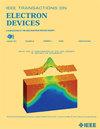Experimental and Simulation Study on the Failure Mechanism of GaN HD-GIT Under Overcurrent Stress
IF 3.2
2区 工程技术
Q2 ENGINEERING, ELECTRICAL & ELECTRONIC
引用次数: 0
Abstract
This article investigates the failure mechanisms of the gallium nitride high electron mobility transistors (GaN HEMTs) under overcurrent stress. The overcurrent behavior of GaN hybrid drain-embedded gate injection transistor (HD-GIT) devices was evaluated under different stress conditions, and the primary failure modes were identified. The waveforms of the GaN devices during overcurrent events were analyzed in stages, and the physical mechanisms underlying each stage were analyzed. Numerical technology computer-aided design (TCAD) simulations were conducted to analyze the electric field distribution and the variations in electron mobility during overcurrent stress. Both thermal runaway and drain/substrate breakdown failures were investigated through simulation analysis. The results indicate that thermal runaway failure in GaN HEMTs occurs due to the accumulation of thermal stresses in the access region, which is triggered by the reduction in electron mobility and an increase in the electric field within the channel. The drain and substrate breakdown failure are mainly caused by the high vertical electric field between the drain and substrate due to hole injection from the drain p-GaN region. Furthermore, the failure mechanisms were validated through experimental tests.过流应力作用下GaN HD-GIT失效机理的实验与仿真研究
本文研究了氮化镓高电子迁移率晶体管(GaN HEMTs)在过电流胁迫下的失效机理。研究了氮化镓杂化漏极嵌入栅注入晶体管(HD-GIT)器件在不同应力条件下的过流行为,确定了其主要失效模式。分阶段分析了GaN器件在过流过程中的波形,并分析了每个阶段的物理机制。采用数值技术计算机辅助设计(TCAD)模拟分析了过流应力作用下的电场分布和电子迁移率的变化。通过仿真分析研究了热失控和漏极/衬底击穿失效。结果表明,氮化镓hemt的热失控失效是由于通道内电子迁移率的降低和电场的增加引起通道内热应力的积累。漏极和衬底击穿的主要原因是由于漏极p-GaN区空穴注入造成的漏极和衬底之间的高垂直电场。并通过试验验证了其破坏机理。
本文章由计算机程序翻译,如有差异,请以英文原文为准。
求助全文
约1分钟内获得全文
求助全文
来源期刊

IEEE Transactions on Electron Devices
工程技术-工程:电子与电气
CiteScore
5.80
自引率
16.10%
发文量
937
审稿时长
3.8 months
期刊介绍:
IEEE Transactions on Electron Devices publishes original and significant contributions relating to the theory, modeling, design, performance and reliability of electron and ion integrated circuit devices and interconnects, involving insulators, metals, organic materials, micro-plasmas, semiconductors, quantum-effect structures, vacuum devices, and emerging materials with applications in bioelectronics, biomedical electronics, computation, communications, displays, microelectromechanics, imaging, micro-actuators, nanoelectronics, optoelectronics, photovoltaics, power ICs and micro-sensors. Tutorial and review papers on these subjects are also published and occasional special issues appear to present a collection of papers which treat particular areas in more depth and breadth.
 求助内容:
求助内容: 应助结果提醒方式:
应助结果提醒方式:


